Centurion › Cerdic › A Visual Glossary of Hindu Architecture » Origins and History
Articles and Definitions › Contents
- Centurion › Origins
- Cerdic › Who Was
- A Visual Glossary of Hindu Architecture › Origins
Ancient civilizations › Historical places, and their characters
Centurion › Origins
Definition and Origins
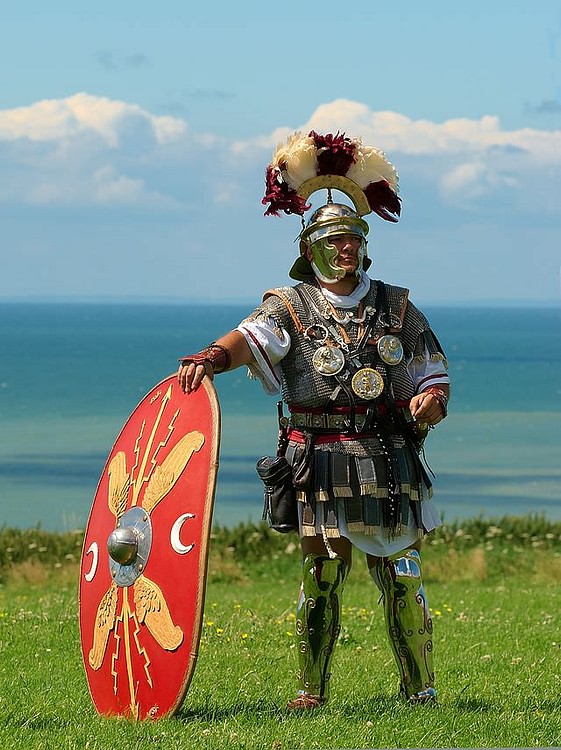
The centurion, or centurio in Latin, has become the most famous officer in the Roman army, and his experience and valour were indeed a crucial factor in maintaining order on the battlefield and ensuring Rome 's military successes spanned over centuries. Commanding a unit of around 100 legionaries, he was also responsible for assigning duties, dishing out punishments, and performing various administrative duties, which ranged from distributing camp passwords to the escort of prisoners. Centurions could also rise to higher administrative positions within the empire, but the name centurion would forever be associated with the grizzled veteran who, emblazoned with decorations, led by courageous example on the battlefield.
ORIGINS & EVOLUTION
According to Roman tradition, the existence of centurion rank went right back to the first armies of Rome in the mid-8th century BCE which, led by the legendary Romulus, had 3,000 men and 30 centurions, each commanding a 100-man infantry group known as a manipulus, which also had its own standard or signa. According to Dionysius of Halicarnassus, the centurion rank had Etruscan origins and was incorporated into the Roman army by the Etruscan king of Rome Servius Tullius (rc 579-534 BCE), the rank being given to the bravest soldiers in battle.
Over time the organization of army units evolved, and by the late 6th century BCE, the army had two legions, each composed of 3,000 heavy hoplite infantry, 1,200 light infantry, and 300 cavalrymen. In the 4th century BCE, further reforms re-shaped the manipuli into more flexible military units deployed in three lines of troops ( acies triplex ), so that the number of infantry commanded by a centurion was reduced to 30. Therefore, a 4th century BCE legion ( legio ) had 150 centurions.
Polybius describes the army units of the mid-2nd century BCE where there were 4,000 men to a legion that now included light skirmishers. The legion in this period was divided into 30 manipuli with a total of 60 centuriae units each commanded by a centurion who appointed his own junior officer ( optio ). Two centuriae made up a maniple and the most experienced centurion took the right wing. Of all these centurions, the most senior was the primus pilus, who also had a seat on the military council.Following Marius ' reforms in 107-104 BCE, the centurion given command of the right centuria of the maniple was known as the prior centurio, whilst he on the left wing was called the posterior. Centurions usually took position in the front rank of their troops during battle, which resulted in their disproportionate fatality rate in battle.
CENTURIONS WERE EXPECTED TO LEAD BY EXAMPLE AND DISPLAY THE GREATEST COURAGE ON THE BATTLEFIELD.
By the 1st century BCE, the army was re-arranged into cohorts ( cohors ), each consisting of six 100-man centuriae. Each legion had ten cohorts so that the number of centurions in a legion remained 60. Their titles of prior and posterior were also maintained, as was their seniority based on which type of troops they commanded - (from the least senior) hastati, principes, and pili (younger, experienced, veteran troops, respectively) and the seniority of their centuriae within a particular cohort.
ENTRY REQUIREMENTS
Traditionally centurions came from the lower plebeian class, but by the 1st century BCE the rank also became associated with members of the higher equestrian class. The post was open to non-Latins and centurions could be appointed through election, appointment by the Senate or promotion from the ranks, especially for those who displayed great bravery or leadership qualities in battle but, in the imperial period, also as a direct commission without prior military experience. There were even cases of direct appointment by the emperor himself.
As the Roman army became ever more professional so too the requirements to become a centurion became stricter and, at least for the most senior centurion positions, a certain ability in administrative affairs became necessary, even the support of an influential patron. On the other hand, and although most centurions maintained that rank throughout their career, it now became possible for senior centurions to go even higher in the hierarchy and become tribunes, prefects, and even members of the Senate. Emperor Maximinus Thrax, a centurion under Caracalla, showed that in turbulent times even the highest position of all was possible, and Vespasian 's father and grandfather had also served as centurions.

Roman Armour
UNIFORM & ARMOUR
Centurions often wore a helmet ( galea ) with a distinctive transverse crest ( crista transversa ), which was typically silver with a died hair or feather plume, typically ostrich or peacock feathers. In the imperial period the crest could also be front to back on the helmet. Early centurion helmets could also have a face guard or mask sculpted into the form of, for example, a horned Silenus. In later Rome centurion helmets carried insignia in silver. His armour included greaves ( ocreae ), which usually had engraved decoration, and a bronze cuirass ( thorax stadios ) chest plate, either belly-shaped or sculpted to replicate muscles or incorporating scaled armour ( lorica squamata ). Alternatively he could wear a leather version or lighter stiffened linen cuirass ( linothorax ). Chest (and back) armour could also have shoulder guards ( humeralia ) and protective hanging strips ( pteryges ) for the upper arms and groin and even a neck protector at the back. In the 1st century CE a short-sleeved ring-mail armour vest was also common amongst centurions. A tunic was worn under the armour, which for centurions was either white, off-white, or various shades of red. A cloak ( sagulum ) could be worn, which was typically blue or green with a yellow border and tied at the front using a brooch or fibula. A centurion also carried a 90 cm vine-stick cudgel ( vitis latina ) as a measure of his rank. The typical shield in the Republic was either the circular clipeus or the rectangular scutum. In the Imperial period oval shields could be carried, but generally the centurions seem to have used the same shield type as the troops under their command. On top of all this, centurions also wore the awards they had received for valour, which could include heavy necklaces ( torques ), bracelets ( armillae ), and medallions ( phalerae ) which were worn attached to a leather chest harness.
WEAPONS
In the early Republic, weaponry for centurions varied, often depending on their rank and personal preference. They could carry a spear ( hasta ) and sword ( ensis ), the latter being worn on the left side, which was in contrast to the legionaries who wore theirs on the right hip. Different swords were used but the most favoured was the straight double-edged xiphos or the curved machaira. From the 2nd century BCE the gladius hispaniensis became the sword of choice. With a length around 65 cm, it usually had a trilobate or hemispherical pommel and was carried in a silver scabbard hung either on a balteus strap hanging over the shoulder and across the chest or from a belt ( cingulum ). A dagger ( pugio ) around 25 cm long could also be worn, often hanging horizontally from the belt.
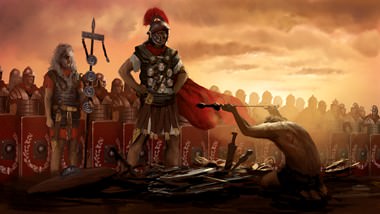
Roman Victory
DUTIES
Reporting to the tribunes, centurions were responsible for training legionaries, assigning duties, and maintaining discipline amongst the ranks. They themselves were expected to display valour in battle and stand resolute when things were not going so well, and if they did not they could face execution. Accordingly, most centurions commanded respect from the troops in their charge through leading by example. Centurions were, though, also noted for their sometimes brutal physical discipline. When in camp they supervised the building of the camp fortifications, the digging of trenches, roll calls, and the issuing of passwords to enter camp. They could also be responsible for escorting prisoners, erecting dedicatory monuments, and involved in logistics such as procuring a supply of provisions when on campaign.
Other roles of centurions included being ultimately responsible for the safety of the legion's standards, and they were often selected for special missions such as raids and reconnaissance in enemy-held territory. By the 1st century CE centurions were regularly given the job of commanding special police and intelligence units ( frumentarii ), sub-units of auxiliary forces ( auxilia), which were composed of non-citizen soldiers, and units of allied armies ( numeri ). Experienced centurions might also become aides to provincial governors or train troops as exercitores. Senior centurions also participated in war councils to decide strategies and were involved in peace talks with the enemy. In the imperial period, centurions also served in the emperor's personal bodyguard, the Praetorian guard, and after 16 years of service could join the evocati who were given various urban administrative roles that included such lucrative positions as town commandants.
In the late Republic, centurions were paid five times more than a normal legionary. Centurions also received a higher bonus from war booty, as, for example, in 64 BCE when Pompey gave each centurion a bonus of 1,000 drachmas whilst legionaries got only 50 drachmas each. By the 1st century CE, centurions were getting 15 times the pay of a legionary, senior centurions considerably more. Centurions were also notorious for bolstering their pay with bribes, as it was they who assigned duties and recommended promotions for the men below them.
FAMOUS CENTURIONS
One famous centurion was the legendary Lucius Siccius Dentatus, known as the 'Roman Achilles ', who, in the 5th century BCE, participated in a staggering 120 battles and at least eight single combat duels. He also found time to single-handedly recapture his legion's standards, and he boasted no fewer than 45 battle scars. Spurius Ligustinus enjoyed a 22-year career in the 2nd century BCE, during which he won 34 separate awards for courage and ability on the battlefield. The centurion mentioned most often in Julius Caesar 's accounts of the Gallic Wars is one P. Sextius Baculus, also known as 'the Staff', who once saved Caesar 's life on the battlefield. Such are the names of just a few of the long line of battle-scarred veterans who, over the centuries, made the rank of centurion respected and feared by both Roman and enemy troops alike.
Cerdic › Who Was
Definition and Origins

Cerdic (reigned 519-534 CE) was King of the West Saxons and the founder of Wessex. His influence was so profound that later genealogies of the English monarchy would claim that all the sovereigns of Britain, save for Canute, Hardecanute, the Harolds, and William the Conqueror, were descended from him. Precisely why he was so influential is debated, however, in that the ancient sources conflict in their accounts of his life, who he was, and what he accomplished -- so much so, in fact, that a number of historians in the present day question whether Cerdic even existed. Early sources, traditional legends, and later novels claim he fought against King Arthur but also claim he was granted Wessex by that king. There are also historians who claim Cerdic was the historical figure upon whom the Arthurian legends are based and link both Arthur and Cerdic to the Welsh hero Caradoc Vreichvras, while other writers claim Cerdic was the model for Mordred in the Arthurian cycles. He is alternately described as a British earl who led a Saxon army, an English noble, a Saxon commander, a Welsh hero, and an English king. His depiction in the 2004 film King Arthur is emblematic of the problem in identifying who he actually was. That film, which presented itself as historically accurate and claimed to draw on original sources, portrays Cerdic as a Saxon warlord who is defeated by Arthur at the Battle of Badon; Cerdic is never mentioned in any account of Badon, even though it seems he was well known enough that he would have been had he been engaged there.
WE CANNOT AUTHORITATIVELY STATE THE TRUTH OF MANY OF THE SUPPOSED "FACTS" CONCERNING CERDIC'S LIFE, SAVE THAT HE WAS KNOWN AS THE FOUNDER OF WESSEX.
The primary sources on Cerdic's life and reign are the historian Nennius (9th century CE), The Anglo-Saxon Chronicles (9th-12th centuries CE), and Geoffrey of Monmouth (12th century CE), among others. As the information about him in these sources is so slight, later writers seem to have felt compelled to fill in these blanks, which has resulted in various interpretations of Cerdic's life. The fact that so many later writers felt the need to do so is testimony to how important Cerdic was in English history. It is generally accepted that Cerdic was an actual historical figure who founded Wessex and then embarked on campaigns to expand his kingdom and, essentially, founded the nation known today as England ; the details of these campaigns, however, were never recorded or were lost, resulting in the embellishments to his life noted above.
CERDIC IN THE ANGLO-SAXON CHRONICLES
The Anglo-Saxon Chronicles are manuscripts first begun in the late 9th century CE under the reign of Alfred the Great (849-899 CE). They continued to be written, edited, and re-written through the 12th century CE and record the history of Britain from 1 BCE through 1154 CE. The problems with reliabilility of The Anglo-Saxon Chronicles have been noted by many historians over the centuries and, chief among these difficulties, is that the entries (recorded in one or two lines per event per year) provide little detail of the events and often repeat themselves in different years. A further difficulty is in understanding exactly which year is being referenced, since the practice of dating the beginning of the year to January 1st had not yet been implemented. Some scribes seem to recognize the start of the new year as Christmas, while others date it to Easter. An entry, then, for 519 CE, might actually have taken place in 520 or 518 CE. In the case of Cerdic, these problems have forced historians to agree on which dates are most likely correct and work from there. Although a narrative of Cerdic's life and reign can be constructed by this method, it does not mean that the generally accepted dates are the correct ones.
Historian John Morris, in his controversial 1973 CE work The Age of Arthur, makes many claims that have been criticized by historians but is quite often accurate when describing the sources one must rely on. Regarding The Anglo-Saxon Chronicles, he writes:
The early West Saxon entries in the Saxon Chronicle are exceptionally confused, duplicated under different dates and, at first sight, contradictory. The confusion has a special cause. The easier ambiguities of the Kent and Sussex annals are the consequences of fading memory and of tradition ill-understood; but the Wessex entries are the deliberate contrivance of ninth-century scholars, devised to serve the political needs of their own day.Their story is that the kingdom of Wessex owed its origin to Cerdic, who was in command of a number of separate Saxon forces under named leaders, at a date that was originally set at about 480. Cerdic is the only founder of an English kingdom who has an unequivocably British name. His pedigrees alone are patent inventions, for his 'ancestors' are lifted from the straightforward traditions of other English dynasties, and later Wessex kings are represented as his descendants by improbable and contradictory links that credit some of them with two or three different fathers (103-104).
The standard version of Cerdic's story that Morris refers to relates how Cerdic arrived in Hampshire in 495 CE with his son, Cynric, in five ships and instantly defeated the Welsh (or, alternately, the Britons). After this victory, he established a home base in Wessex from which he campaigned further to establish the Kingdom of the West Saxons by 519 CE, when he was crowned king. This version of his life is based on the entries in The Anglo-Saxon Chronicles, which read:
- 495: This year came two leaders into Britain, Cerdic and Cynric his son, with five ships, at a place that is called Cerdic's-ore. And they fought with the Welsh the same day.
- 508: This year Cerdic and Cynric slew a British king, whose name was Natanleod, and five thousand men with him. After this was the land named Netley, from him, as far as Charford.
- 514: This year came the West-Saxons into Britain, with three ships, at the place that is called Cerdic's-ore.And Stuf and Whitgar fought with the Britons and put them to flight.
- 519. This year Cerdic and Cynaric undertook the government of the West-Saxons; the same year they fought with the Britons at a place now called Charford. From that day have reigned the children of the West-Saxon kings.
- 527: This year Cerdic and Cynric fought with Britons in the place that is called Cerdic's-ley.
- 530: This year Cerdic and Cynric took the Isle of Wight, and slew many men in Carisbrook.
- 534: This year died Cerdic, the first king of the West-Saxons. Cynric his son succeeded to the government and reigned afterwards 26 winters. And they gave to their two nephews, Stuf and Wihtgar, the whole of the Isle of Wight.
This account is straightforward enough but lacks the details from which to create a complete story; this is why later writers felt the need to supply their own details. Drawing upon the earlier sources, historian George H. Townsend created his work The Manual of Dates in 1862 CE and, for 520 CE, wrote how Cerdic "fought the reknowned King Arthur." Other scholars have also suggested a strong link with Arthur, some claiming Cerdic was Arthur's son or nephew and others claiming they were adversaries. The battle of 527 CE at Cerdic's-ley is another possibility (besides the 520 CE conflict), proposed as a battle between Cerdic and Arthur. It is accepted, however, that in 530 CE Cerdic conquered the Isle of Wight, having already established his kingdom and clearly having at his disposal an army and navy. These entries in the Chronicles and later interpretations from other sources epitomize the difficulty in reconciling the sources of the time into a single, cohesive narrative. The historian Nennius, who is thought to have written his History of the Britons in 828 CE, claims Arthur never lost a single one of his famous twelve battles which would have taken place in the 6th century CE. It seems unlikely, if Arthur had defeated Cerdic in 520 or 527 CE, that he would have then allowed him to continue ruling in Wessex, much less go on to conquer the Isle of Wight in his own name and for his own glory.
CERDIC AS ARTHUR
The historians John C. and Joseph W. Rudmin claim that the difficulty of reconciling the ancient sources on Cerdic with those of Arthur is easily solved once one recognizes that they were the same person. Regarding Cerdic's founding of Wessex and his subsequent rule, and the claim that Arthur ruled the same territory at the same time, they write:
There is no good solution to the problem of Arthur presiding over the territory and time of the founding of the Saxon kingdom of Wessex - unless he presided over it! If, in the year 500, the ruler of south-central Britain was Arthur, and the ruler of south-central Britain was Cerdic, then Arthur was Cerdic. For over a thousand years, the literature of Britain has had a lost king and a forgotten victory. Now the identity of the national hero of Wales has been discovered, and he has turned out to be the founder of the kingdom of England (24).
The evidence, they point out, speaks for itself once on realizes that Cerdic is identical to the Welsh hero Caradoc Vreichvras (also known as Caradoc Breifbras in the Arthurian legends). To cite only a few of the comparisons they make: "Arthur" and "Vreichvras" both mean "strong arm"; both are associated with Wessex and, especially, Winchester; both are illegitimate sons;both dominate the region later known as Wessex c. 500 CE; Arthur is the son of Uther and Igerna while Cerdic is the son of Elessa and Isaive; and Arthur marries Guinevere of Cornwall, Cerdic marries Guignier of Cornwall. All of these similarities, it is claimed, prove Arthur and Cerdic to be one historical figure whose exploits were so notable that they were mythologized by later writers as the Arthurian Legends, which were finally collected, edited, and substantially expanded upon by Sir Thomas Malory in the 15th century CE.
The problem with the Rudmin's claim, as they themselves admit, is that it "makes too many assumptions" and so, "by the standards of some historians...is not an acceptable paper" (2). Still, their claim is interesting to consider, even if it cannot be definitively proven. One of the more serious problems with their claim is that if the British Cerdic is identical to the Welsh hero Vreichvras, even if that could be proven, there is still the difficulty of substantiating that Vreichvras was Arthur, since Vreichvras is known as a Knight of the Round Table who served under both Uther and Arthur and is never identified as either. He is recognized as the ancestor of the later kings of Gwent in Welsh legend, and as a Welsh noble, but not as king of the Britons.
CERDIC AS A BRITISH EARL
While it is unlikely that Cerdic was Arthur, it is even less likely that he was a Saxon. Even though the Anglo-Saxon Chronicles seem to present Cerdic as a Saxon war leader, it has been noted by a number of historians besides Morris or the Rudmins (such as Professor Johann P. Sommerville of the University of Wisconsin) that "Cerdic" is a British name, not Saxon. The claim of a number of historians is that Cerdic was a British earl who was driven from the region and took refuge in Brittany from whence he later returned in 495 CE at the head of a Saxon force.
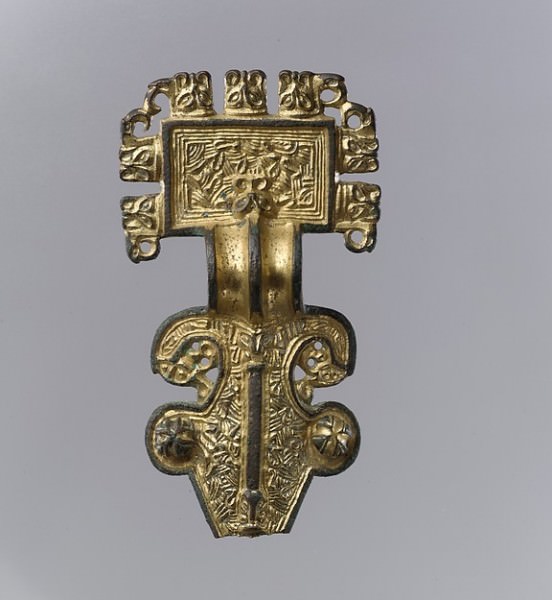
Saxon Square-Headed Bow Brooch
Evidence for Cerdic as a British earl associated with the Saxons is suggested not only by his name but also by passages in the works of Nennius and Geoffrey of Monmouth. The historian Frank D. Reno, writing on Cerdic's nationality, states:
Plummer, the foremost authority on the manuscripts of the Chronicles, has this to say about the entry of 495, the very first entry in which Cerdic makes an appearance: "495 - The coming of the West Saxons; the foundation, as it proved, of England. It is curious to find the traditional founder of the West-Saxon kingdom, the source to which all West-Saxon pedigrees are traced, bearing a name Cerdic, Certic, so like the Welsh Ceredig, Ceretic. It is worth nothing that in Nennius, Chapter 37, Ceretic is the name of [King] Hengist's interpreter" (111).
In the passage from Chapter 37, one "Ceretic" acts as interpreter between Vortigern, King of the Britons, and Hengist of the Saxons, and historians have claimed that Cerdic, the later West Saxon king, is the same man as Ceretic the interpreter from Nennius. The scholar Richard Barber cites Nennius' lines regarding Ceretic at Vortigern's court: "No other Briton among the Britons knew Saxon except this man; and he applied himself to acquiring knowledge of it (or reading it) until he was able to understand the Saxon speech" ( The Figure of Arthur, 112). Cerdic, according to these claims, was an influential earl who could speak the Saxon tongue and who also commanded an impressive military force. Geoffrey of Monmouth mentions Cerdic as an ally of Hengist and Vortigern in Chapter VI.13 of his History of the Kings of Briton when Vortigern and Hengist call for "gallant warriors" to come help them defeat the barbarians: "and Cerdic came with three hundred ships (Nennius says 40) all full of an armed host, all of whom did Vortigern receive kindly, bestowing upon them unstinted largesse. For by them he conquered all his enemies and won every field that was fought."
At some point, after his service to Vortigern, Cerdic left the mainland for Brittany, gathered a Saxon force there, and returned in 495 CE. The apparent ease of his victories between 495-519 CE suggests to some historians that he was already a well-known and respected leader. Historians (including the Rudmins) point to the original name of the region of Wessex, "Gewisse", as further proof that Cerdic and his followers were already known in the land prior to 495 CE, as they interpret the place-name "Gewisse" as linked to the German word "gewiss" ("certainly" or "sure"), which was the same word in Old Saxon and had the same meaning. The Kingdom of Gewisse, according to this argument, would have been known by that name because Cerdic was "certainly known" or "surely known" and so his territory was called "the Kingdom of the One Who is Known". Other explanations for Wessex being originally known as The Kingdom of Gewisse make far less sense, such as the claim that it was named for Cerdic's mother.
THE CERDIC OF HISTORY
The truth behind the original name of the kingdom, like much of Cerdic's life, may never be known and is still debated in the present day. The understanding of "accuracy" in reporting historical events was not held to the same standard in the 9th -12th centuries CE as it is today and, as noted above, each source seems to indicate a slightly, or significantly, different kind of narrative. Even Nennius, who is regularly regarded as reliable, is suspect; as Barber notes, "Nennius...is both an antiquarian with political motives and an author conscious of continental traditions" (85). His narrative, therefore, needs to be read in light of those motives and traditions, not as an objective history. Geoffrey of Monmouth has long been criticized for making up large segments of his "history" right down to his claim that he is only translating an ancient work he found. Each author who addressed himself to the topic of Cerdic's life and reign seems to have had a particular agenda to advance (as was stated by Morris, above). The historian Roger Collins comments on this, regarding "history" and place names, writing:
There is an unbridgeable chronological gulf between the supposed founding period of the notional kingdom of Wessex in the late fifth century and the next period in which those who are said to be members of its ruling house appear, in the second half of the sixth century. Much of the information relating to the early phase is of a distinctly `folkloric' or rationalizing character: for example, Cerdic and Cynric land at a place called Cerdicesora;they kill a 'Welsh' king called Natanleod, and subsequently that district is called Natanleod (Netley near Southampton), and so on. It must be suspected that the place names preceded the persons referred to, rather than the reverse, and that the history of the latter was concocted to explain the existence of the former (178).
This same paradigm could hold true for the original name of the kingdom before it was known as "The Kingdom of the West Saxons" and then shortened to "Wessex". It might also be true that Cerdic was, in fact, known in the region and had already established himself there firmly prior to his departure, for whatever reason, to Brittany; or it may not be. There is no way to authoritatively state the truth of many of the supposed "facts" concerning Cerdic's life, save that he was known as the founder of Wessex. Even the claim that all English monarchs descended from Cerdic is open to question since, as Collins notes, "Genealogical information is equally dubious. [The later Saxon king] Ceawlin's relationship to Cerdic and Cynric is never specified in the Chronicle, though he is said in the entry for the year 560 to have succeded to the kingdom of Wessex that they created" (178). The dubious genealogy is the result of later scribes with their own agendas; Cerdic's nationality had to be altered by the later genealogy of the 9th century CE to align him with the Angles, who grew in power from their kingdom of Northumbria to finally rule all the land, instead of with the Britons who were among the people they conquered. Morris writes:
A ruler with a British name, with no ancient tradition of English forebears or English descendants, is plainly British. Though he was the earliest ruler of the future Wessex whom the later English knew, the claim of ninth century Wessex kings to suzerainty over all the English could not be built upon the authority of a British king. He had to be treated as an Englishman. The relationships are invented; but the substance of the tradition that had to be disguised is itself ancient. Cerdic was regarded as the ruler of the Winchester-Southampton area in the late fifth century, as the commander of the Saxons who landed in that area, and as a king who consistently fought with the English against the British armies...Excavation [in the present day] locates and dates the homes of his federates, and suggests where he raised them (104).
There once was, it seems, a man named Cerdic who either arrived or returned to England in 495 CE, founded Wessex, and established a powerful kingdom which, in time, would evolve into the nation known as England. England, the "land of the Angles", embraced this early king as their founder, anglicized him through genealogies, and made him one of their own. Who the actual Cerdic was, what he did, and why he made such an impression, remains unclear; the Cerdic who was created by the later writers is the Cerdic of history.
A Visual Glossary of Hindu Architecture › Origins
Ancient Civilizations
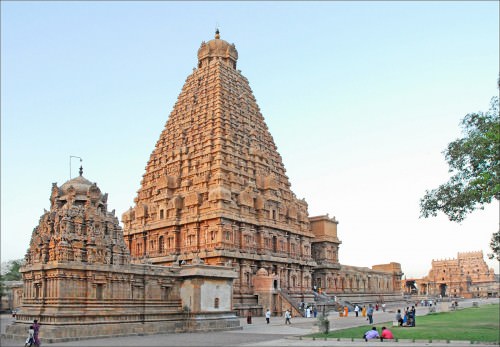
The Brihadishvara Temple, Thanjavur
Adisthana - the decorative raised platform on which a temple is built.
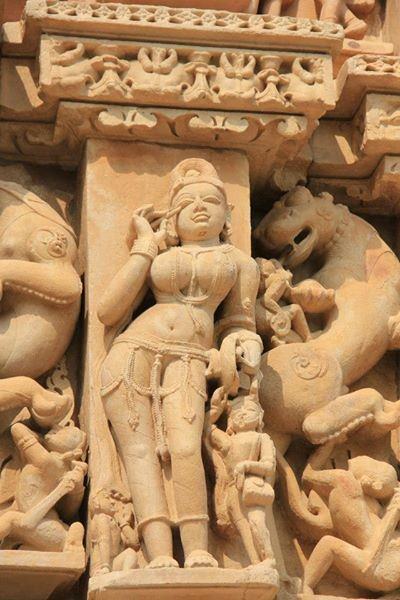
Figure en toilette, Khajuraho
Alasa kanya - a decorative female figure.

Muktesvara Temple, Bhubaneshwar
Amalaka - a large fluted stone disc placed on top of a Nagara tower taking its form from the amla or myrobalan fruit native to India.
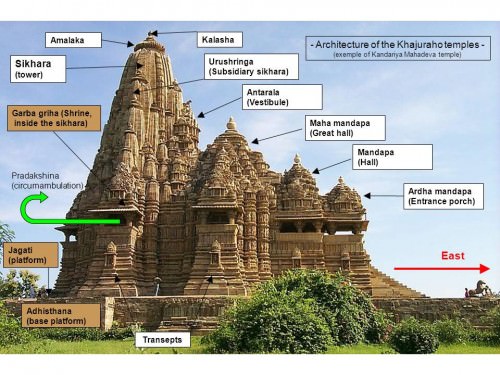
Features of Hindu Architecture
Antarala - an antechamber to the inner sanctum or garbhagriha of a temple.

Durga Temple, Aihole
Ardhamandapa - a temple portico serving as an entrance porch.
Bho - a medallion motif of Orissan architecture which projects from towers and shows a monster regurgitating garlands flanked by two dwarfs.

Principal Features of a hindu Temple Complex
Bhoga mandapa - (or Bogh-mandir ) a hall in Orissan temples which is used for consecrated food preparation and distribution.
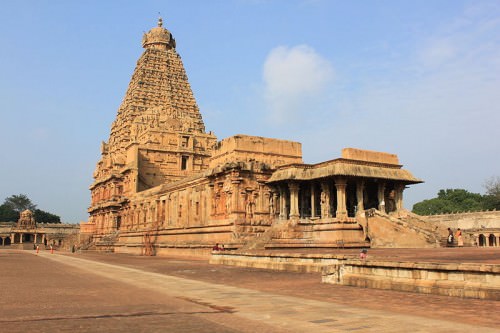
Brihadishvara Temple, Thanjavur
Devalaya - the general name of a temple meaning a god's dwelling place.

Shore Temple, Mahabalipuram
Dravida - the style of southern temple architecture.

Garbhagriha, Pattadakal
Garbhagriha - (also garbha grha ) meaning 'womb-chamber,' the small windowless room that is the main shrine of the temple, usually containing a representation or symbol of the principal deity.
Ghana dvara - blind doorways of the garbhagriha, which symbolically allow the energy of the deity to radiate through and beyond the temple. They may also act as secondary niche shrines.
Ghanta - a bell-shaped finial on the top of a tower.
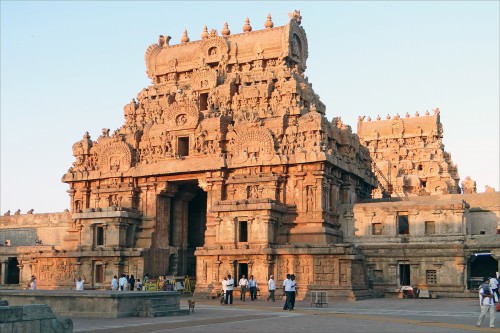
Monumental Gateway, Brihadishvara Temple, Thanjavur
Gopura - a monumental gate tower of Dravida temples.
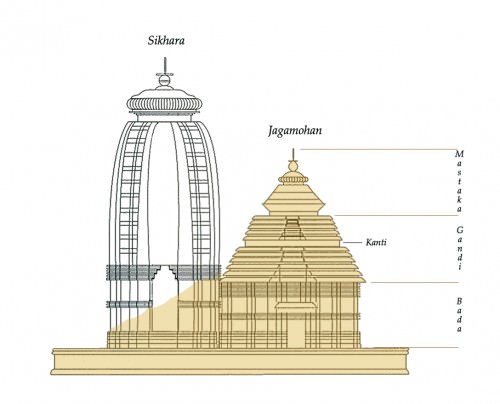
Surviving Jagamohana of the Konark Sun Temple, Orissa
Jagamohana - the mandapa or entrance hall of an Orissan temple.
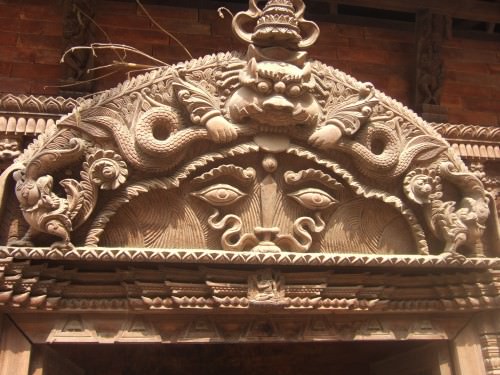
Kirtimukha, Nepal
Kirtimukha - a decorative lion or monster motif with the lower jaw missing, typically placed over doorways.
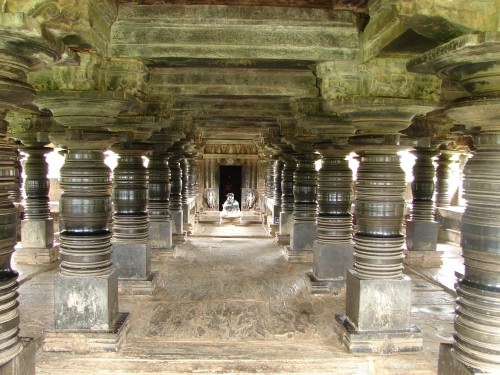
Mandapa, Amritheswara temple
Mandapa - a columned hallway which leads to the garbhagriha or inner sanctum.
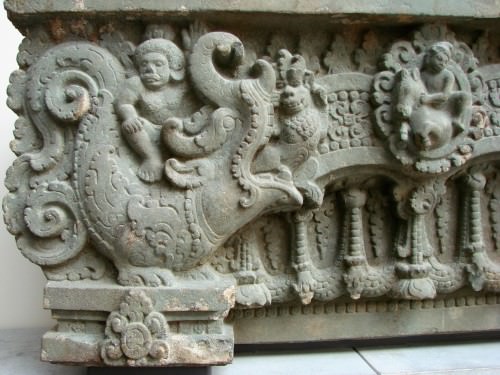
Makara, Cambodia
Makara - a decorative sea monster motif.

Parsvanatha Temple, Khajuraho
Nagara - the style of northern temple architecture.
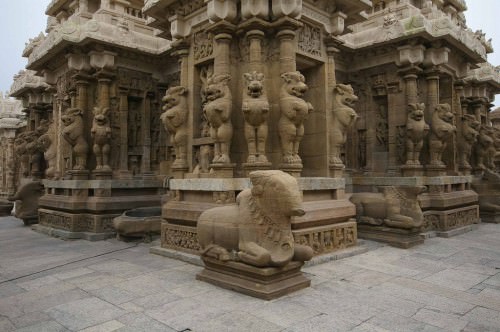
Vimana, Kailasanatha Temple, Kanchipuram
Nandi Mandapa - a pavilion which contains a statue of Shiva 's gatekeeper and vehicle, the bull Nandi.
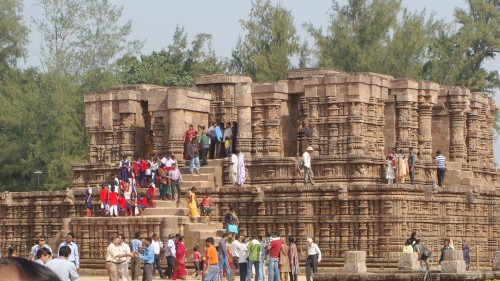
Nata Mandapa, Konark
Nata mandapa - (also nata mandir ) the dance hall in Orissan temples, added from the 10th century CE.
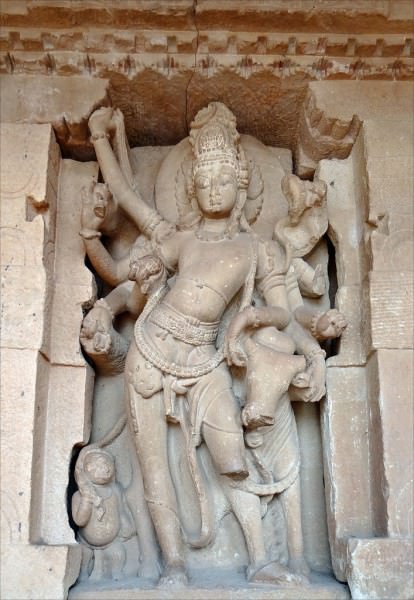
Shiva with Nandi, Aihole
Nataraja - a decorative dancing Shiva motif.
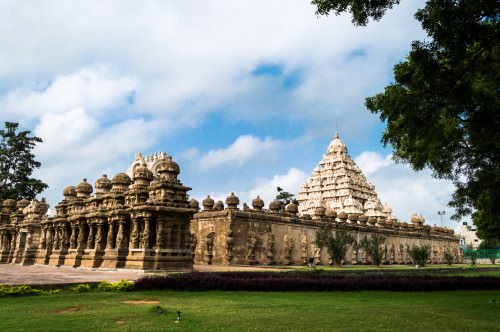
Kailasanatha Temple, Kanchipuram, India
Prakara - a high wall which encloses a temple.
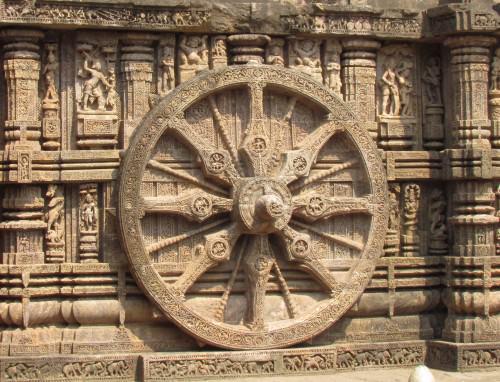
Wheel, Konark Sun Temple
Ratha - a projection on the exterior wall of a Nagara temple; there are typically seven on each side. Also the name for the chariot of the sun god Surya which sun temples represent via spoked wheels on the outer walls.

Bhima & Dhamaraja
Sala - a barrel-vaulted roof in Dravida architecture, often represented as an architectural motif.

Rajarani Temple, Bhubaneshwar
Sikhara - the tower of a Nagara temple which is built directly above the inner sanctum or garbhagriha. Also the decorative top of a tower in Dravida temples.
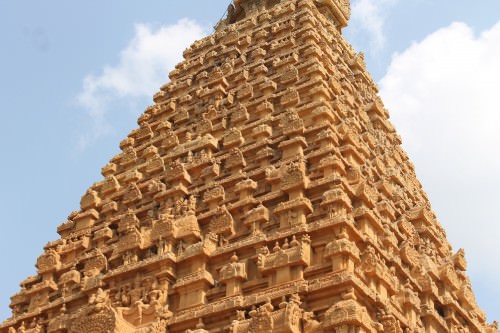
Talas of the Brihadishvara Temple
Tala - the tiers of a vimana tower.
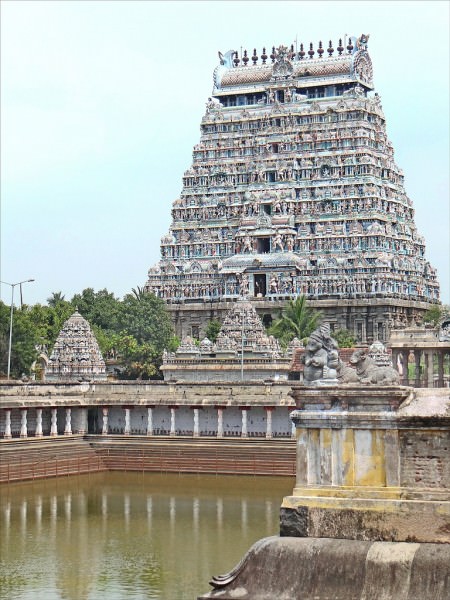
Gopura & Nataraja Temple, Chidambaram
Temple tank - a ritual bathing tank or pool common in southern temples.

Kandariya Mahadeo Temple, Khajuraho
Urushringa - a smaller, subsidiary tower, usually joining or enclosing the main tower.
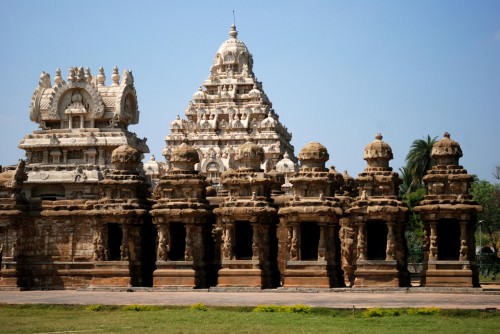
Kailasanatha Temple, Kanchipuram
Vimana - the more rounded tower of a Dravida temple. Typically they are topped by a small dome.
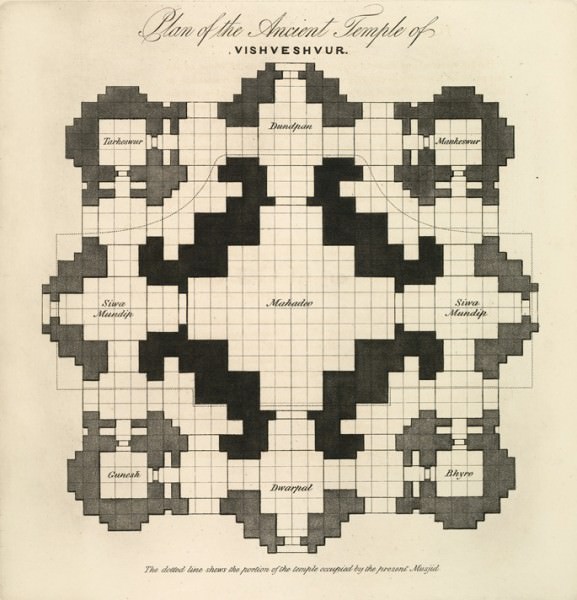
Temple Vastu-Purusa-Mandala
Vastu- purusa - mandala - the symbolic symmetrical floorplan which Hindu temples follow.

Somanathapura, Vesara Style Temple
Vesara - the style of architecture which mixed Nagara and Dravida styles.

Vyala (Yali)
Vyala - (also y ali ) the decorative lion monster seen in many Hindu temples.
LICENSE
Article based on information obtained from these sources:with permission from the Website Ancient History Encyclopedia
Content is available under License Creative Commons: Attribution-NonCommercial-ShareAlike 3.0 Unported. CC-BY-NC-SA License